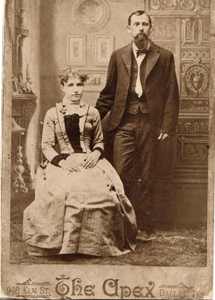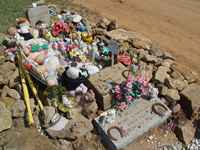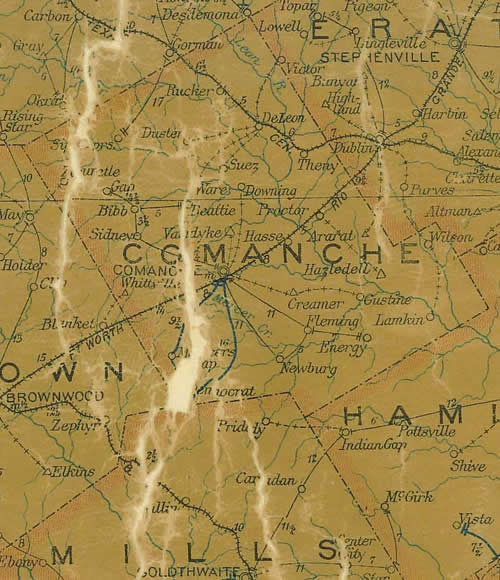Sipe Springs Texas, Comanche County ghost town. (original) (raw)

Sipe Springs oil well
Photo courtesy Chris Jefferies
History in a Pecan Shell
The town was named for springs that "seeped" out of the earth. First settlers arrived around 1870. The town was organized in 1873 and the first school was built that same year.
A post office was granted in 1883, and the town had a thriving population of 130 the next year.
Around 1890 the town had their own newspaper, and in 1911 the Texas Central Railroad built through - just north of the town. A short-lived oil boom occurred from 1918 - 1921 with an estimated 8,000 to 10,000 people arriving to share in the wealth. The town built an opera house and supported a professional baseball team. Buildings went up overnight, but many disappeared in a 1922 fire after most of the population had already left (only 575 in 1924).
In 1937 two Sipe Springs schools served 152 pupils with instruction provided by six teachers. Dwindling ground water added to the depressed economy and many simply farmers gave up. By 1940 the community had 200 persons and it went down to only 120 by 1949.
The state-wide school consolidations of the 50s eliminated the Sipe Springs schools and students were sent to De Leon or Sidney. The population was reported to be 110 in 1974.

"Francis Ella �Frank� and Margrette Ellen (Small) Barnes, my great grandparents."
- Lea Peacock, Roaring Springs, Texas
The Sipe Springs Cemetery appears on the detailed TxDoT county map of Comanche County.
The cemetery can be reached by driving north from FM 587 (.3 of a mile from the former townsite). A fork appears in the road and the left fork will take you to the cemetery after a half-mile drive.
Historical Marker:
Sipe Springs Cemetery
Pioneers settled this area about 1870, after finding water seeping from a spring. There was controversy from the beginning over the correct spelling of the name, which is pronounced "seep." The town soon grew into a milling and ginning center for this region. Upon the death of Pratt Scarlett in 1873, John C. Smith (1828-1907) gave five acres for a cemetery, but the title was not clear. A large stone carved with Scarlett's death date was buried at the foot of his grave. Several burial sites in the old part of the cemetery have plain sandstone markers. In 1890 the area residents built a tabernacle at the burial ground. Enlarged in 1951, it is still used for gatherings such as the annual homecoming in July.
An oil boom came to Sipe Springs in the winter of 1918 and the village grew to almost 10,000. The town boasted an opera house and a professional baseball team. About that time Nels and Sarah Crain acquired a clear title to the cemetery tract. Their heirs gave it to the Sipe Springs Cemetery Association. The graveyard is still in use today with about 1150 grave sites including veterans from the Civil War and Spanish-American War; World War I, World War II; and the Korean and Vietnam conflicts.
(1978)
Sipe Springs Chronicles:
Sipe Springsby Mike Cox ("Texas Tales" Column)Surely her grieving parents wrote her name in their family Bible, noting the day she died. Once, maybe, a wooden grave marker bore her name.
But all that remains today is a mystery written in concrete: "Who is the little girl, age 3?"
Those eight words sum up just about everything anyone living today knows about the lonely, rock-bordered grave.
Some say the little girl fell off the wagon and suffered a fatal head injury. Another story has her dying of disease, which seems more likely. Her family buried her where she died and then continued their journey.
Local folks at some point started putting flowers on the grave. Then someone offered a small toy. Over the years that tradition has grown.
Three years after the little girl's death, someone settled at a seeping spring a short distance west of her grave. The community came to be called Sipe Springs. It's pronounced "Seep" Springs, incidentally, not the way it's spelled. Whether that spelling was accidental or based on a variant acceptable in the 19th century remains open to discussion.
Unusual as its name is, Texas once had two places called Sipe Springs. The other, never as big as the one in Comanche County, was in Milam County. A hundred years ago, it had a two-teacher school with three score students, but the school closed due to consolidation in 1931 and within a decade nothing was left of the Milam County community.
Not that all that much is left of the Comanche County Sipe Springs. One old bank still stands. Someone has recently restored an old stone house that once stood in ruins. And there's the Masonic Hall, though it's a new one built when the original structure burned down not too long ago.
West of the intersection that marks the center of the community are the ruins of an old saloon. Jerry Morgan, owner of the DeLeon Free Press, said he found a late 19th century nickel in the vicinity several years ago.
For a time in the late teens and early 1920s, a lot of nickels slid across the bar in and around Sipe Springs. Though named for water, the town got renewed vitality from the discovery of another liquid - oil.
Some say Sipe Springs had 10,000 residents for a time. Children crowded a large community school. Two banks did a flourishing business, as did numerous stores and eateries. When not busy earning money, local folks and roughnecks had entertainment choices ranging from an opera house to a professional baseball team.
But the shallow oil field played out, and so did Sipe Springs. The government finally closed the post office in 1957, but the boom days already were long gone by then.
Though Sipe Springs has had a minor population spurt from city folks buying country retreats, for years the only growth going on in Sipe Springs was at the cemetery.
Land for the cemetery was donated in 1873, but for some reason, no one moved the little girl's grave to the site. In 1890, a wooden tabernacle went up and the number of graves increased over the decades.
A granite marker in that cemetery presents another mystery, though with a little research into old newspapers, it is still solvable.
Photographs of a teenage boy and his sister are set into the stone, which reads simply "Brother" and "Sister." On another stone is inscribed "Marion Wayne Mote 1922-1937" and "Patty Mote 1925-1937."
The story left untold is this line on their gravestone: "Happy and gay, to school they went one day....They are not dead, just away."
�
Mike Cox"Texas Tales" Column
Sipe Springs, Texas Forum
- Subject: Sipe Springs oil well photo
I have an image titled �My first Oil Well at Sipe Springs Texas�. I have no idea if it is related to our family, or how it came to be in our collection. I am attaching the image in the hopes that there may be something familiar to someone there. The image has been cut, possibly to highlight someone else in another presentation. Please let me know what this may be about or who it might refer to. Thanks. - Chris Jefferies, December 04, 2006 - Subject: Sipe Springs Memories
Your article brought back a lot of memories for me of my Great Grandparents who moved to Sipe Springs in 1892 from Arkansas. I used to visit and stay with them a week at a time as they only lived 17 miles from us at De Leon, Texas. Great Grandpa Francis Ella �Frank� Barnes and I would go to town every afternoon to Sipe Springs in the buggy with �Old Joe� the gray horse hitched up and spend the after noon. Great Grandmother Margaret Ellen �Maggie� would take her nap while we were gone. It was especially a fun time when my brother R.C. Henderson and Helen, Bobby, Genevieve and Peggy Barnes, children of Edwin Barnes some times would be there and we had many a good time at that old farm. We rode an old buggy frame down the hill to the bottom to the bridge, played in the wheat barn, and drove the old Case Car miles and miles while it was setting in the barn. Ole Joe the horse, would go to the back of the pasture and we would chase him many a mile until we caught himh, so we could all ride him.
My grandfather James Calvin Marvin Barnes and great grandfather would sit out on the porch and Great Grandfather would talk and talk and tell of his days in the Mexican War and Civil War, but I was at that time too busy playing and did not listen to them. Oh, how I wish now that I had.
Great Grandfather Barnes was Justice of the Peace there for years. I remember one time a couple came to get married on a Saturday night. We kids were all told to go out side. We did, but were peeping in a window and watched the wedding. We would read the Justice of Peace book, Great Grandma would let us know when Great Grandpa was coming and we would scatter quick.
Those buried there in the Sipe Springs Cemetery that are my folks are: Francis Ella Barnes & wife Margrette Ellen(Small) Barnes, Minnie (Barnes) & Frank Morrison, and son Paul Morrison; Myrtle Barnes Richardson, Daisy Barnes Williams & husband A..Z Williams, Marvin & Annie Nolen Barnes, and son George E. Barnes, Margaret (McFarland ) Arnold Todd (has no stone); James Nolen, son of Wm. E. & Minerva Jane (Mauney) Nolen. Carrie (Small) & Eli McGinty, Cora L. McGinty, Katy Small, Willie May Small (daus of J.W. Small); 2 children of Nelse and Sarah (Adar) Crain , Nelse and Sarah Adair Crain, So many stories I could tell, but this is already too long. - Lea Peacock, Roaring Springs, Texas, May 28, 2006 - My Mother lived at Sipe Springs as a child and graduated from high school (or should I just say 'school') there. Her name was Leetie Placker, and during her junior and/or senior years there, she was paid a small sum to teach classes.
Mom was really the class valedictorian but that honor was only given to male students at the time. She had the highest grade average.
Mom always spoke about Sipe Springs with fond memories about life there. She lost her little sister to diptheria or some disease. They were real pals and spent most of their time together until her sister died.
Her Father, Lazarus Baird Placker was a transplant from Menard, Texas where he grew up on a ranch. He was a good man, and heavy on principles. Mom helped him make syrup for area people who grew sugar cane. He had a press that was a turntable pulled around by a horse. They cooked the cane sap down and made syrup for a share.This helped give the family extra money. Other than that, they farmed and raised their meat and chickens.
Grandmother was �Susie Etta Welsh�, a tall happy woman who was from a family of singers. They went around singing in Churches etc. and I believe that is where Grandad (Poppa) Placker met her. I could go on, but I don't know If this will fall on receptive ears. Thank You - Ray Gaines (Son of Leetie), January 5, 2004
1907 postal map showing Sipe Spring in NW Comanche County
From Texas state map #2090
Courtesy Texas General Land Office
Texas Escapes, in its purpose to preserve historic, endangered and vanishing Texas, asks that anyone wishing to share their local history, stories, landmarks and recent or vintage photos, please contact us.

